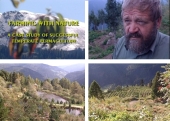Hi Mike
You can direct seed wheat, corn, but after the garden bed soil is a bit more mature (1 yr later). In year 1 I would start with shallow-rooted things like herbs, salad greens.. part of learning is experimenting, too.
For onions, carrots, I would recommend seed trays so the sprouts don't get obliterated by slugs, squirrels, or birds.
I have successfully grown clover (a green composter) alongside my vegetables. Clover grows insanely fast so it takes maintenance, be prepared with clippers regularly and for your loved ones to get anxious that there are "too many weeds" in the garden (one of the main reasons I don't do that anymore.) Remember beans add nitrogen to the soil, and there are a variety of perennial shrubs and such that will add nitrogen to the soil, reducing the need for green compost. Dandelions make excellent green compost, but even better salads :)
Burying logs in the garden bed releases nutrients over time, too, and builds soil. Now the green composting strategy can be diversified. Sowing a cover crop at the end of fall is a great way to get some thing to chop n drop in the spring. If that cover crop doesn't fix nitrogen or put nutrients back in the soil, it'll be consuming them instead, so think about that.
I do not dig in my beds and have not since I started my garden 3 yrs ago. Anything that dies in the winter, I clip above the roots and drop the remainder right on the bed there. I started my garden beds by creating layers of "bio mass". I got a lot of stuff at the beginning from my neighbors, who don't spray their lawns or landscapes. They were just taking bags of "yard waste" to the curb, and I asked them for the bags. Those made excellent fill for garden beds. Autumn is perfect for getting leaf bags for soil building.
All the above plus your own compost pile should build a nice healthy soil. There are even more ways to make great soil.









